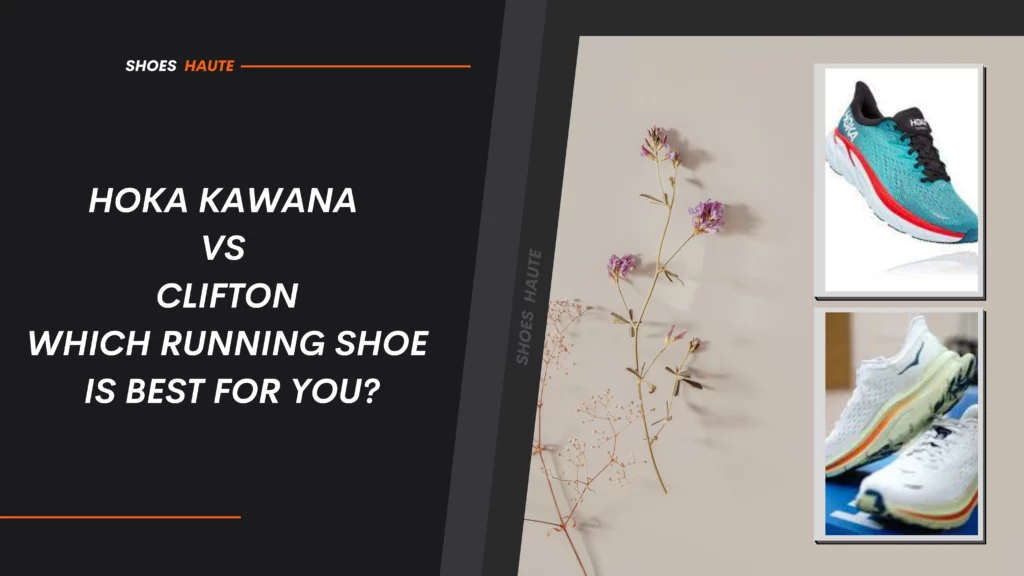
Being an avid runner, I understand the importance of finding the perfect running shoe. It can completely change your running experience by offering both comfort and improved performance while minimizing the risk of injuries.
However, with numerous options available in the market, it can be overwhelming to select the right one that suits your specific needs.
That’s why I’m thrilled to delve into a detailed comparison of two popular models – Hoka Kawana and Clifton. By examining their features, benefits, and potential drawbacks, we can gain a comprehensive understanding of what distinguishes these shoes from each other.
This knowledge will enable you to make an informed decision for your next run. So let’s get ready and explore the distinctive qualities of each shoe!
Contrasting Hoka Kawana and Clifton
As I examine the Hoka Kawana and Clifton models simultaneously, I discern various significant parallels that render them equally remarkable selections for runners.
Key Similarities Between Kawana And Clifton
Foremost, it is crucial to emphasize that both shoe options epitomize Hoka’s dedication to delivering unparalleled comfort and cushioning.
They seamlessly integrate Hoka’s signature elements such as Meta-Rocker technology and lightweight construction to create an agile running experience like no other.
The Kawana model along with the Clifton model effectively utilize Hoka’s renowned cushioning technologies including the PROFLY midsole – striking an ideal equilibrium between lavish cushioning and responsive energy return. This harmonious blend results in a ride that offers optimal support while minimizing stress on joints and muscles for ultimate comfort during your runs.
Additionally, both shoes boast exceptional breathability thanks to their mesh uppers which facilitate outstanding airflow – ensuring coolness and dryness of your feet throughout your workout sessions.
Furthermore, the lightweight design of these models contributes significantly to an effortless sensation while promoting natural foot movement for an enhanced running experience overall.
Differentiating Factors That Make Each Shoe Unique
Although the Kawana and Clifton have similarities, they also possess individual characteristics that distinguish them from each other.
Hoka Kawana
If you’re looking for a running shoe that offers a touch of snappy responsiveness along with a slightly firmer ride, the Kawana is your best bet.
It strikes the perfect balance between cushioning and energy return, making it suitable for runners who desire both comfort and performance.
Moreover, despite being relatively lightweight, the Kawana provides additional stability and support to cater to those who prefer some structure in their running shoes.
Hoka Clifton
One noticeable contrast lies in the amount of cushioning provided. The Clifton offers a more indulgent and comfortable experience with its plush and pillowy feel.
Moreover, the overall weight of the shoes differentiates them further. The Clifton is slightly lighter than the Kawana, appealing to runners who prioritize a lightness in their footwear while still desiring ample cushioning.
Understanding How These Distinctions Affect Various Types Of Runners
Runners of different types and their specific needs are affected differently by the distinctions between the Kawana and Clifton.
Hoka Kawana
The Kawana is the ideal choice for runners seeking a shoe that strikes the perfect balance between comfort and performance.
Whether you’re into tempo runs, intervals, or competitive races, this versatile shoe caters to all your training needs.
Its midsole offers just the right amount of firmness while delivering snappy responsiveness, resulting in a lively ride that boosts speed and agility.
Hoka Clifton
If you’re looking for comfort during long-distance runs or when recovering from intense workouts, the Clifton is an excellent choice.
Its plush cushioning ensures a soft and forgiving ride that effectively absorbs impact during extended periods of running.
Moreover, the lightweight design reduces leg strain, providing a comfortable and efficient experience for runners.
Individual Running Style And Foot Mechanics
When deciding between the Kawana and Clifton, one must consider their individual running style and foot mechanics.
Those with a neutral foot strike may find satisfaction in either model, allowing them to choose based on personal preferences.
However, individuals with specific requirements such as overpronation or underpronation can benefit from the enhanced stability and support provided by the Kawana.
Major Differences: Hoka Kawana VS Clifton
In order to facilitate the decision-making process, I have compiled a detailed comparison table outlining the significant variations between Hoka Kawana and Clifton.
| Feature | Hoka Kawana | Hoka Clifton |
|---|---|---|
| Cushioning | Offers a responsive and energetic feel | Provides plush and comfortable cushioning |
| Stability | Boasts excellent stability features | Offers less stability support |
| Fit | Features a roomier toe box | Provides a comfortable fit |
| Heel to Toe Drop | Has a 5mm heel-to-toe drop | Maintains a 5mm heel-to-toe drop |
| Durability | Known for long-lasting durability (400 miles) | Designed to last (500 miles) |
| Terrain Suitability | Primarily designed for road running | Suitable for both road and trail running |
| Weight | Designed with a lightweight build (10oz) | Lightweight construction (8.8oz) |
| Pronation Support | Suitable for runners with pronation issues | Offers limited arch support |
| Price | Falls within a higher price range | Also belongs to a higher price range |
| Long-Distance Running | Suitable for long-distance running | Ideal for long-distance runs |
| Color Options | Provides a limited selection of colors | Offers a wide range of color choices |
| Durometer Test | Measures 21.4 in durometer test | Scores 20 on the durometer test |
Fit And Comfort: Hoka Kawana VS Clifton
The performance of both Hoka Kawana and Hoka Clifton can be evaluated by considering the importance of fit and comfort as crucial features.
Evaluating The Fit And Comfort Aspects Of Kawana
When it comes to providing an optimal fit and unmatched comfort, the Hoka Kawana truly excels. With its design specifically crafted to offer a glove-like fit, this shoe ensures that your foot remains snugly secured without any unwanted slippage whatsoever.
Additionally, the upper material of this shoe is constructed from lightweight mesh that not only allows excellent airflow but also keeps your feet cool and dry throughout your runs.
Furthermore, I found that regardless of your foot shape, you will find the Kawana’s fit accommodating due to its spacious toe box that prevents uncomfortable pressure points from forming during your runs.
Moreover, thanks to its minimal overlays combined with seamless construction in the upper section of this shoe, you can expect reduced friction or irritation which ultimately enhances overall comfort levels significantly.
When discussing comfort levels in relation to footwear, it would be remiss not to mention the vital role played by cushioning – an area where the Kawana truly shines through! This shoe boasts a PROFLY midsole with dual-density foam construction which provides an incredibly plush and cushioned feel underfoot.
By incorporating a softer heel section that effectively absorbs impact, paired with a firmer forefoot foam that offers impressive responsiveness and energy return, the Kawana manages to strike the perfect balance between cushioning and responsiveness.
This winning combination ultimately contributes to an exceptionally comfortable and smooth-running experience that you won’t soon forget.
Assessing The Fit And Comfort Aspects Of Clifton
Known for its exceptional fit and cloud-like comfort, the Hoka Clifton model is highly regarded in the footwear industry.
Its spacious toe box allows for natural toe splaying, eliminating any discomfort caused by cramped spaces. This generous fit provides a sense of liberation while preventing any potential foot pain or irritation.
Additionally, similar to the Kawana model, the Clifton’s upper is constructed with a lightweight mesh material that promotes breathability and prevents excessive sweating during physical activities.
With minimal overlays and a seamless design, this shoe ensures maximum comfort by minimizing friction points or areas prone to irritation.
Notably, one of its standout features is its plush cushioning provided by the midsole foam which delivers an incredibly soft feeling underfoot.
This feature guarantees an indulgent experience during both shorter sprints or longer runs as it effectively absorbs impact forces while reducing stress on joints and muscles
Understanding The Significance Of Fit And Comfort For Different Foot Types And Running Preferences
The running experience and overall performance of all types of runners are directly influenced by the fit and comfort of a running shoe, making them crucial factors to consider.
Hoka Kawana
Designed to cater to runners with narrower feet or a preference for a locked-in feel, the Kawana guarantees a secure and snug fit.
With its exceptional balance of cushioning and responsiveness, this shoe ensures an exhilarating and dynamic ride, perfectly suited for runners who relish faster-paced runs, tempo workouts, or competitive races.
Hoka Clifton
The Clifton is a great choice for runners with broader feet or those who desire a looser fit. Its spacious toe box and generous sizing provide ample room for comfortable movement.
Furthermore, the abundant cushioning not only adds to the overall comfort but also meets the needs of long-distance or endurance runners.
Additionally, it offers a soft and forgiving feel that appeals to runners seeking that extra level of support underfoot.
Foot Types
In addition, it is crucial to understand one’s foot type as it greatly influences selecting suitable footwear that ensures a proper fit and optimal comfort level. Runners who possess high arches can greatly benefit from both the Kawana and Clifton models due to their ability to provide adequate cushioning and support.
This feature aids in absorbing shock during running sessions while evenly distributing pressure across the feet, effectively minimizing any potential discomfort or injury risks.
Conversely, individuals with flat feet or overpronation can take advantage of the enhanced stability and support offered by the Kawana model specifically designed for such conditions.
Its secure fit combined with a structured design helps control pronation while promoting correct alignment, resulting in heightened overall comfort levels along with a reduced likelihood of experiencing overuse injuries.
Durability And Longevity: Hoka Kawana VS Clifton
Now, let’s witness the performance of both shoes in this regard.
Exploring The Durability And Longevity Of Kawana
In terms of durability, the Hoka Kawana is an exceptionally long-lasting shoe that runners can rely on for their regular training needs. Its construction and materials contribute to its overall durability.
The upper, constructed with high-quality mesh and minimal overlays, ensures that the shoe maintains its shape and structure over time.
The outsole, made from a sturdy rubber compound, offers excellent traction and resists wear even on rough surfaces.
During my experience with the Kawana, it proved to be highly resilient to the demands of my training routine.
The upper remained intact without any noticeable signs of wear or tearing. The outsole’s grip remained dependable across various terrains.
Despite extended use, the midsole cushioning maintained its softness and comfort without significant compression.
Investigating The Durability And Longevity Of Clifton
Like the Kawana, the Hoka Clifton boasts impressive longevity as a running shoe option due to its exceptional durability.
The upper of the Clifton is made with a combination of mesh and lightweight materials that exhibit remarkable resilience against wear and tear.
To reinforce the structure of the shoe, overlays and stitching are incorporated into its design, significantly enhancing its overall durability.
Through my personal experiences with the Clifton model, I have observed that it maintains its integrity even after extensive use.
Remarkably, there were no noticeable signs of significant wear or damage on the upper material despite repeated workouts.
Furthermore, over time, I found that the outsole’s rubber compound proved to be highly durable as it retained both grip and traction exceptionally well.
Even after extended periods of use, I was pleased to discover that despite having soft and plush midsole cushioning characteristics; they still maintained their responsiveness and support levels effectively.
Considering Factors That Affect The Longevity Of Running Shoes
The durability of running shoes can be influenced by several factors regardless of their specific model.
One significant factor is an individual’s running style and frequency of use.
Those with a heavier stride or who engage in high-mileage training may notice faster deterioration compared to occasional or lighter runners.
The primary terrain on which the shoes are used also affects longevity; rough surfaces like trails or concrete place additional stress on shoe materials which could lead to accelerated wear and tear.
Proper maintenance such as regular cleaning and appropriate storage practices contribute significantly to overall shoe lifespan as well.
Furthermore, implementing proper shoe rotation strategies aids in extending longevity; alternating between multiple pairs allows for recovery and decompression between runs, reducing strain on the materials and cushioning. Lastly, weight and foot mechanics play a role in shoe durability.
Heavier runners may experience more pronounced compression of cushioning materials over time, while those with specific gait patterns or biomechanical issues like overpronation or supination may exert uneven pressure on certain areas of the shoe, potentially leading to faster wear in those regions.
Stability And Support: Hoka Kawana VS Clifton
Now that we have assessed Fit and Comfort, Durability, and Longevity, let us examine Stability and Support.
Analyzing The Stability And Support Features Of Kawana
The Hoka Kawana is designed to cater to various runners’ needs by offering a well-balanced combination of stability and support.
While it may not be explicitly marketed as a stability shoe, it still delivers adequate support for those who require moderate stability.
The key features that contribute to its stability include the dual-density foam midsole, which provides a firmer platform under the arch area and promotes controlled foot strikes.
This is particularly advantageous for runners with mild to moderate overpronation as it helps maintain neutral alignment and prevent excessive inward rolling.
Moreover, the secure fit and structured design of the Kawana enhance its overall stability by minimizing foot movement through its snug upper and external heel counter.
Examining The Stability And Support Features Of Clifton
When it comes to stability and support, the Hoka Clifton takes a different approach than other shoes like the Kawana.
Instead of relying on specific stability features, it prioritizes offering a well-balanced and comfortable ride for runners.
The Clifton achieves this through its well-engineered design that inherently provides stability.
Its midsole is generously cushioned and constructed in a way that creates a supportive platform for runners, ensuring that their feet remain centered and supported throughout their stride.
While it may not have as many dedicated stability features as other shoes, such as the Kawana, its cushioning helps promote neutral foot alignment for many runners.
Furthermore, the Clifton’s upper contributes to its overall support by offering a secure fit with lightweight materials and strategically placed overlays that reduce foot movement within the shoe.
Determining The Impact Of Stability And Support On Different Running Styles And Pronation Types
The impact of stability and support in running shoes varies considerably based on individual factors such as a runner’s specific needs, running style, and pronation type.
For those with a neutral foot strike pattern, both the Kawana and Clifton models offer suitable support to ensure proper alignment throughout every phase of their stride.
These shoes feature cushioning that effectively absorbs shock, reducing discomfort or injury risks associated with inadequate support.
However, individuals who exhibit mild to moderate overpronation may find greater benefits from utilizing the Kawana model’s additional stability features.
By employing its supportive midsole alongside a well-structured design, this shoe actively guides the foot towards a more neutral alignment while simultaneously minimizing excessive inward rolling motion – ultimately providing an exceptionally stable platform for optimal foot function.
Important Note:
On the other hand, it is worth mentioning that runners with severe overpronation or specific stability needs may need to consider opting for more specialized stability shoes or incorporating additional support features that surpass the offerings of the Kawana or Clifton.
Terrain And Performance Specialization: Hoka Kawana VS Clifton
The performance of both shoes varies depending on the train.
Exploring The Ideal Terrain And Performance Specialization Of Kawana:
The Hoka Kawana is a multi-purpose running shoe that caters to the unique demands of various terrains and running preferences.
While it delivers top-notch performance across different surfaces, it truly thrives in specific conditions.
On Roads And Pavements
Experience unparalleled performance with the Kawana as you traverse roads and pavements.
This exceptional shoe boasts responsive cushioning and a lightweight construction, making it an excellent choice for runners seeking an invigorating and fast-paced workout.
Its design encourages an efficient stride that allows you to effortlessly maintain a steady pace while maximizing your performance on even surfaces.
Whether you’re training for an upcoming road race or simply embarking on a quick jog around your local area, the Kawana guarantees the necessary support and responsiveness to elevate your running experience.
Light Trail Running
When it comes to light trail running, the Kawana never disappoints in terms of reliable performance.
While it may not possess the same rugged attributes as a dedicated trail shoe, its stability and multidirectional lugs on the outsole ensure decent traction even on less challenging trails.
This renders the Kawana an ideal option for runners who occasionally venture off-road or seek variety in their training regimen by incorporating both road and trail running activities.
Investigating The Ideal Terrain And Performance Specialization Of Clifton
The Hoka Clifton, similar to the Kawana, offers adaptability for different terrains and specialized performance. Nevertheless, their strengths diverge in specific aspects.
Road Running
Designed primarily for road running, the Clifton excels on pavement with its exceptional cushioning and plush midsole that provide a luxurious feel underfoot.
It is an excellent choice for long-distance road running due to its ability to absorb shock and reduce impact on joints and muscles during extended periods of running on hard surfaces.
Whether you’re training for a marathon or enjoying a leisurely jog, the Clifton’s comfort and cushioning ensure a smooth and enjoyable road running experience.
While it can handle light trails as well, its specialization lies in delivering top-notch performance on roads.
The shoe’s lightweight construction coupled with its responsive ride make it perfect for runners who prioritize speed and efficiency when running on flat, even surfaces.
Although the outsole may not offer aggressive traction like dedicated trail shoes do, it still manages non-technical trails with moderate ease.
Understanding How Terrain And Performance Factors Influence Shoe Selection
Selecting a suitable running shoe requires careful consideration of both the terrain you’ll be tackling and your desired performance outcomes.
Each type of terrain demands specific features in order to optimize performance while minimizing injury risks. For runners who primarily stick to roads or pavements, both the Kawana and Clifton models from Hoka offer excellent choices.
The Kawana boasts impressive responsiveness and stability for those seeking a dynamic ride experience, while the Clifton focuses on exceptional cushioning that prioritizes comfort during long road runs.
If you frequently find yourself venturing onto trails or enjoying off-road escapades, then the stability features and outsole traction of the Kawana make it a better fit for light trail running activities.
However, if your trail runs involve technical terrains or more challenging surfaces, it’s advisable to explore dedicated trail running shoes that come with more aggressive outsole designs.
In the end, comprehending how terrain and performance factors influence shoe selection is crucial. It’s essential to consider the specific demands of your running environment, your performance goals, and your personal preferences when deciding between the Hoka Kawana and Clifton models.
By evaluating the unique features and characteristics of each shoe, you’ll be able to make an informed decision that not only enhances your running experience but also caters to your individual needs.
Who Is The Real Winner Between Hoka Kawana VS Clifton?
In terms of personal experience, making a decision between the Hoka Kawana and Clifton has proven quite challenging for me. Each model possesses unique characteristics and benefits that make it difficult to declare an outright winner clearly.
However, after conducting extensive testing and careful consideration, I have found that the Hoka Clifton emerges as truly superior in comparison.Initially trying on the Clifton left an immediate impression as I was struck by its plush cushioning and luxurious feel.
The soft yet responsive midsole provided exceptional comfort, allowing me to log long distances without experiencing any discomfort or fatigue.
The Clifton’s cushioning not only effectively absorbed impact but also offered a spring-like response that enhanced my running efficiency.
Fit is another crucial factor for me, and the Clifton’s narrow fit was a perfect match for my feet. The shoe securely hugged my feet without any restrictive feeling, providing a locked-in sensation that boosted my confidence with every stride.
Additionally, the seamless upper construction reduced the risk of irritation or hotspots, ensuring a smooth and blister-free running experience. Durability is an important consideration, particularly for runners who subject their shoes to intense training sessions.
In this regard, the Clifton exceeded all expectations. Despite its lightweight design, the shoe demonstrated remarkable durability with minimal signs of wear and tear on both the outsole and upper even after extensive use.This impressive longevity added value to my investment while instilling unwavering confidence in its performance.
The Clifton excels in providing reinforcement without compromising its lightweight nature when it comes to stability and support.
As someone who runs with a neutral gait pattern, I was pleased with how well the shoe accommodated my natural stride while offering a balanced platform.
While it may not offer as much stability as the Kawana model does, the combination of cushioning and responsiveness in the Clifton ensures a supportive and secure running experience. The shoe’s ability to perform well on both road and trail surfaces further solidified its position as superior in terms of terrain versatility.
Although it lacks aggressive lugs or rugged features typically found in dedicated trail shoes, the Clifton’s outsole still provides sufficient traction on non-technical trails without compromising performance during road or light trail running sessions.
Reflecting on my personal experience considering all these factors leads me to conclude that for me personally, the Hoka Clifton emerges as the ultimate winner due to its exceptional cushioning properties, comfortable fit, durability, and ability to adapt to various terrains.
However, it is important to note that preferences and needs may differ among individuals, so trying on both the Kawana and Clifton models and considering specific requirements is essential before making a final decision.
Pros And Cons: Hoka Kawana VS Clifton
Both have the following Pros and Cons.
Hoka Kawana
Pros
- Offers responsive cushioning
- Provides excellent stability
- Boasts durable construction
- Offers a snug fit
- Features a lightweight design
- Suitable for long-distance running
- Versatile for different terrains
Cons
- Narrow toe box
- Can be pricey
- Limited color options
Hoka Clifton
Pros
- Provides plush cushioning
- Offers a comfortable fit
- Boasts long-lasting durability
- Versatile for both road and trail
- Features a lightweight design
- Suitable for long-distance running
- Offers a wide range of color options
Cons
- Offers less stability
- Can be pricey
- Provides limited arch support
Conclusion
In summary, both the Hoka Kawana and Clifton are exceptional running shoes that cater to diverse runner profiles with their unique features. Ultimately, selecting between them hinges on individual preferences and specific requirements.
Should cushioning and responsiveness rank high on your list of priorities, then the Kawana may prove more suitable for you. Conversely, if durability and stability are key considerations for you as a runner, then turning towards the Clifton would be wise.
It is essential to factor in elements such as running style, foot mechanics, terrain preferences, and budget when reaching a decision. To conclude succinctly: carefully evaluate your needs before making an informed choice based on what resonates most with you.
Frequently Asked Questions
What is the reason behind individuals choosing to wear Hoka shoes?
Runners and athletes are drawn to Hoka shoes due to their one-of-a-kind design. These shoes provide exceptional cushioning and support while minimizing impact on the feet, legs, and joints. Furthermore, their lightweight structure and breathable materials make them an excellent choice for extended runs or daily activities.
Can the Hoka Clifton be considered a stable shoe?
While the Hoka Clifton may not be explicitly advertised as a stability shoe, it does offer runners in need of some support a satisfactory level of stability. Its robust midsole and broad base work together to provide increased stability and an optimal fit.
Is Hoka Clifton suitable for daily training?
Undoubtedly, the Hoka Clifton is crafted to function as an everyday training shoe for those who engage in frequent jogging or walking. Its emphasis on being lightweight and possessing a cushioned midsole makes it perfect for daily activities. Additionally, its sturdy construction guarantees durability and sustained high performance over time.
Can one find a carbon plate on the HOKA Kawana?
The HOKA Kawana does not feature a carbon plate. Nevertheless, its patented midsole technology, which utilizes EVA foam and rubberized foam, offers enhanced cushioning and support for a smooth and reactive experience.
Do the two models have different sizes?
Despite their shared goal of providing a comfortable and secure fit, the Hoka Kawana and Clifton may have minor variations in fitting. To achieve the ideal fit for their feet, runners should test out both models and consult the sizing guide.
Can runners who overpronate benefit from using Hoka Kawana and Clifton?
Although both the Hoka Kawana and the Clifton offer a decent amount of stability and support, it is advisable for runners who experience pronation issues to consult with an expert to guarantee the best shoe choice and fit.
Can you highlight the key contrasts between the Hoka Kawana and the Clifton?
With its durable outsole, the Kawana trail running shoe ensures excellent traction and long-lasting performance. Meanwhile, the Clifton road running shoe focuses on delivering a comfortable ride with its lightweight design and responsive cushioned midsole.





